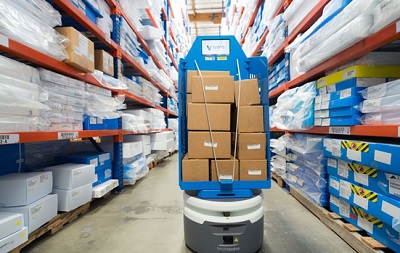Editor’s note: The following column by Stefan Nusser, chief product officer for Fetch Robotics, is part of Modern’s Other Voices column, a series featuring ideas, opinions and insights from end-users, analysts, systems integrators and OEMs. Click here to learn about submitting a column for consideration.
————-
COVID-19 has affected businesses in wildly divergent ways. While the pandemic’s effects have brought service and hospitality businesses to a halt, companies producing vital healthcare and personal protective equipment or household staples and consumer electronics have seen skyrocketing demand. For the manufacturers, warehouses, and logistics firms that produce and distribute these goods, there is an urgent need to step up operations to meet increasing product demand without risking the health of their employees.
Finding and maintaining these employees, however, is a growing challenge. Even before the pandemic, manufacturers and distributors found it difficult to find human labor because unemployment was running at historic lows and key facilities weren’t close to major populations of job seekers. In the presence of COVID-19, some of these facilities are faced with the additional challenges of doing more with even fewer workers, as many employees are staying home to take care of children who are no longer in school and or are simply concerned for their own safety in the workplace. Even for individuals that are able to continue working, social distancing guidelines recommend that they be at least six feet apart, limiting the amount of employees that can be in a facility at any one time.
To close the gap between a reduced workforce and rising demand, essential businesses have begun turning to flexible automation, and specifically to autonomous mobile robots (AMRs), to keep existing workers safe and make it easier for facilities to address temporary labor shortfalls. AMRs are class of robots packed with sensors and on-board computers so they can understand their operating environment and navigate through facilities without any human intervention.
In manufacturing facilities, AMRs are used to enable employees to work at safer distances by acting as the “go-betweens” or runners between workcells or manufacturing line positions. In distribution and fulfillment centers, AMRs enable associates to spend 100% of their time picking instead of 50% of their time moving material around the warehouse in close contact with their colleagues. In both cases, AMRs make it possible for facilities to protect employees by maintaining social distancing while also increasing overall productivity.
Cloud technology is also making it safer for companies to install AMRs in an entirely remote, contactless fashion. Traditionally, installing a new automated system requires vendors to work in the facility for months to complete the initial implementation, but in the era of COVID-19, this exposes employees to increased – and unnecessary – risk. Utilizing cloud-based deployment, vendors can now ship AMRs directly to customer sites, and then use video conferencing to help the customer install the robots and program customized workflows.
This entire process can all be done in less than a day for many facilities. Once deployed, companies can also change their workflows on the fly even if they are not able to come to the office. A process engineer or automation engineer can then modify existing workflows to accommodate additional shifts in fulfillment and distribution centers or create new pick-up locations to align with changes in manufacturing workcell positions.
COVID-19 is forcing essential businesses around the world to rapidly adapt to a new normal of social distancing. For traditionally labor intensive industries like manufacturing and distribution, this means finding new ways to meet demand without adding to, or endangering, their current workforce. As the pandemic continues to spread, companies are increasingly turning to autonomous mobile robots (AMRs), a new class of flexible automation solutions that can be rapidly deployed and easily reconfigured to meet the changing needs of a facility. This is immensely useful to warehousing, logistics, and manufacturing companies looking to operate efficiently while maintaining the social distancing guidelines that are essential in mitigating the spread of coronavirus.
Article topics
Email Sign Up
















